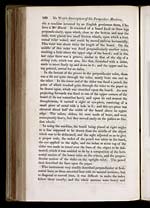James Watt (1736-1819)
Description of a new perspective machine
260
Mr Watt’s Description of his Perspective Machine.
dia a machine invented by an English gentleman there, I be-
lieve a Mr Hurst. It consisted of a board fixed on three legs
perpendicularly, upon which, close to the bottom and near the
ends, were placed two small friction wheels, upon which a hori-
zontal ruler rested, and could be moved endwise horizontally.
This ruler was about twice the length of the board. On the
middle of this ruler was fixed perpendicularly another ruler,
reaching a little above the upper edge of the board; and in this
last ruler there was a groove, similar to that of the slip of a
sliding rule, which was also, like that, furnished with a slider,
made to move freely up and down in it; and the upper end be-
ing pointed, served for an index.
In the bottom of the groove in the perpendicular ruler, there
was a slit cut quite through the ruler, nearly from one end to
the other. In the lower end of the slider was fixed a pencil, the
point of which reached quite through the ruler to the paper to
be drawn upon, which was stretched upon the board. An arm
projecting forwards was fixed to one of the upper corners of the
board (I do not remember how), and upon its end nearest the
draughtsman, it carried a sight or eye-piece, consisting of a
small piece of metal with a hole in it; and this eye-piece was
elevated about half the width of the board above its upper
edge. The rulers, sliders, &c. were made of brass, and were
consequently heavy, but they moved easily on the pullies or fric-
tion wheels.
In using the machine, the board being placed at right angles
to a line supposed to be drawn from the middle of the object
which was to be delineated, and the sight adjusted so as to give
a proper scale, the socket of the pencil was taken in the hand,
the eye applied to the sight, and the index or acute top of the
slider was made to travel over the lines of the object to be deli-
neated, which it was enabled to do by a composition of the hori-
zontal motion of the lower ruler on the wheels, and the perpen-
dicular motion of the slider on the upright ruler. The pencil
then described the lines upon the paper.
This instrument very readily described perpendicular or hori-
zontal lines, as these accorded best with its natural motions; but
in diagonal or curved lines, it was difficult to make the index
follow them exactly, and the whole motions were heavy and


